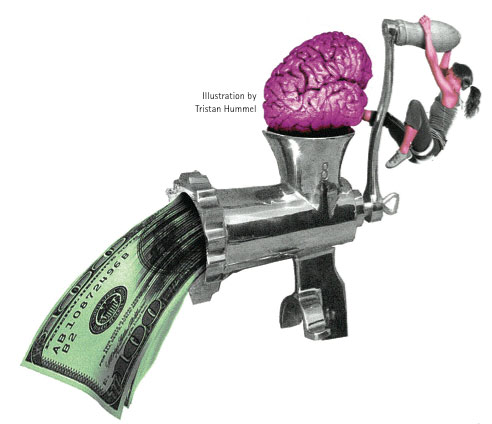As an emerging artist there are some serious roadblocks to financing your ideas. Whether you want to create a painting or open a gallery space, there is a significant amount of capital that you need to invest. The first step towards securing seed money is not just figuring out how to get it but who to get it from.
So whom does the artist go to? Major financial institutions are out, so let’s look at the other possibilities, which include almost anyone. Your friends, family, professors, that guy who owns a bar down the street, your landlord and your cable guy are all possible financiers. Don’t be shy about asking for money if you believe in your idea. My friend’s mother used to tell him, “You get 80% of what you ask for.” In my experience this number is closer to 45%, but that’s still huge.
Speaking of mothers, ask your folks for help. I’m not talking about hitting them up for cash—your parents have been on this earth for who knows how long and have spent most of that time meeting people and forging connections. Ask your folks who they know, and who could lend you time, advice, or even capital. Most importantly, don’t forget to ask for advice, not money. Never ask for money on the first conversation, you need to talk to people and feel it out.
Anyway, catastrophe: you asked your parents about possible contacts and nothing turned up. You even asked them for money and it turns out their entire savings, and the savings of everyone they know, tanked with the stock market. In fact they are counting on you to make enough to care for them in their old age. It’s OK, you go to SAIC, you know at least eight people who are wealthier than most third world countries. Get together a professional proposal for them, offer them some return and make it worth their while. They may come to your aid.
The point of all of this is that every person is a potential investor and you should ask them for their help. Nothing wagered, nothing won. A single large benefactor is amazing but rare, a few smaller revenue streams are more likely and may be to your advantage.
There are three main categories of financing available to you: investments, indirect returns, and donations. A standard investment is when you receive a set amount of capital and pay back the initial amount plus interest (usually 6% to 10% annually). An indirect return is when you receive money and do not have to pay any of it back because your investor believes there are non-monetary rewards to funding you. This type of investment is similar to advertisements. The last and most tantalizing type of financing is donations. The basic idea is that you get a lump sum and are sent on your way to do whatever you wish with no financial obligation in return. Oftentimes, however, there are progress reports or other ‘check-up’ strategies employed by the donor.
When you approach any of these resources, follow the same basic guidelines. Presentation is the first key step. Make it look like your idea already exists, have a rough draft, a super-imposed graph of a planned location for the piece, a timeline for completion or any other sort of information that shows that your project can actually be realized. Your investor is going to need help visualizing what you are talking about, so your proposal should show exactly what you want to do and how you are going to achieve it. Be brief with words and heavy on images. As part of your proposal include a supporting document defining why you will be able to get this done. If an investor likes your work but hates you they are not going to give you money, conversely if they aren’t moved by the artwork but like you personally they may still invest.
If people have confidence in you and can clearly visualize your ideas, they will give you money. Remember that they are more interested in you than your work at this point in your career. You aren’t expected to have everything figured out yet, people will give you breaks because they see that you’re a good long-term investment. Show them you have it in you, and you will be able to catch a lift out of the “emerging artist” world and make a living selling your work, at which point (congratulations) you’ll be able to start worrying about banks. Good luck!










Its well done. Congratulations to Tristan Hummel. Leonor from Argentina.-South Amerika.-